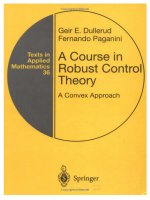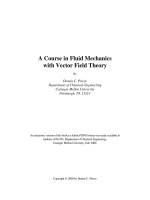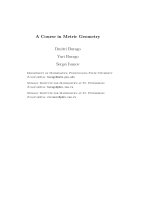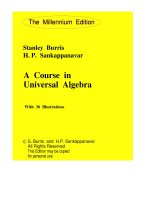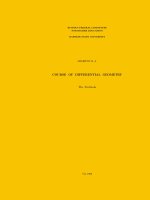A course in differential geometry, wilhelm klingenberg
Bạn đang xem bản rút gọn của tài liệu. Xem và tải ngay bản đầy đủ của tài liệu tại đây (12.51 MB, 188 trang )
Graduate Texts in Mathematics
51
Editorial Board
F. W. Gehring
P. R. Halmos
M anaging Editor
c. C. Moore
Wilhelm Klingenberg
ACoursein
Differential Geometry
Translated by David Hoffman
Springer Science+Business Media, LLC
Wilhelm Klingenberg
Mathematisches Institut der
Universitiit Bonn
5300 Bonn
Wegelerstr. 10
West Gemiany
David Hoffman
Department of Mathematics
Graduate Research Center
University of Massachusetts
Amherst, MA 01003
USA
Editorial Board
P. R. Halmos
F. W. Gehring
Managing Editor
Department of Mathematics
University of Michigan
Ann Arbor, Michigan 48104
USA
Department of Mathematics
University of California
Santa Barbara, CA 93106
USA
AMS Subject Classification:
C. C. Moore
Department of Mathematics
University of California
Berkeley, CA 94720
USA
53-01
Library of Congress Cataloging in Publication Data
Klingenberg, Wilhelm, 1924A course in differential geometry.
(Graduate texts in mathematics; 51)
Translation of Eine Vorlesung iiber Differentialgeometrie.
Bibliography: p.
Includes index.
1. Geometry, Differential. 1. Title. II. Series.
QA641.K5813
516'.36
77-4475
AII rights reserved.
No part of this book may be translated or reproduced in any form
without written permission from Springer-Verlag.
© 1978 by Springer Science+Business Media New York
Originally published by Springer-Verlag, New York lnc. in 1978
Softcover reprint of the hardcover 1st edition 1978
987654321
ISBN 978-1-4612-9925-7
ISBN 978-1-4612-9923-3 (eBook)
DOI 10.1007/978-1-4612-9923-3
Dedicated ta
Shiing-shen Chern
Preface to the English Edition
This English edition could serve as a text for a first year graduate course on
differential geometry, as did for a long time the Chicago Notes of Chern
mentioned in the Preface to the German Edition. Suitable references for ordinary differential equations are Hurewicz, W. Lectures on ordinary differential
equations. MIT Press, Cambridge, Mass., 1958, and for the topology of
surfaces: Massey, Algebraic Topology, Springer-Verlag, New York, 1977.
Upon David Hoffman fell the difficult task of transforming the tightly
constructed German text into one which would mesh well with the more
relaxed format of the Graduate Texts in Mathematics series. There are some
e1aborations and several new figures have been added. I trust that the merits
of the German edition have survived whereas at the same time the efforts of
David helped to elucidate the general conception of the Course where we
tried to put Geometry before Formalism without giving up mathematical
rigour.
1 wish to thank David for his work and his enthusiasm during the whole
period of our collaboration. At the same time I would like to commend the
editors of Springer-Verlag for their patience and good advice.
Bonn
June,1977
Wilhelm Klingenberg
vii
From the Preface to the German Edition
This book has its origins in a one-semester course in differential geometry
which 1 have given many times at Gottingen, Mainz, and Bonn.
It is my intention that these lectures should offer an introduction to the
classical differential geometry of curves and surfaces, suita bie for students
in their middle semester who have mastered the introductory courses. A
course such as this would be an alternative to other middle semester courses
such as complex function theory, abstract algebra, or algebraic topology.
For the most part, these lectures assume nothing more than a knowledge
of basic analysis, real linear algebra, and euc\idean geometry. It is only in
the last chapters that a familiarity with the topology of compact surfaces
would be useful. Nothing is used that cannot be found in Seifert and ThrelfaIl's
classic textbook of topology.
For a summary of the contents of these lectures, 1 refer the reader to the
table of contents. Of course it was necessary to make a selection from the
profusion of material that could be presented at this level. For me it was clear
that the preferred topics were precisely those which contributed to an understanding of two-dimensional Riemannian geometry. Nonetheless, 1 think that
my lectures provide a useful basis for the understanding of aII the areas of
differential geometry.
The structure of these lectures, inc\uding the organization of some of the
proofs, has been greatly influenced by S. S. Chern's lecture notes entitled
"Differential Geometry," pubIished in Chicago in 1954. Chern, in turn, was
influenced by W. Blaschke's "Vorlesungen liber Differentialgeometrie."
Chern had studied with Blaschke in Hamburg between 1934 and 1936, and,
nearly twenty years later, it was Blaschke who gave me strong support in my
career as a differential geometer.
So as 1 take the privilege of dedicating this book to Shiing-shen Chern, 1
would at the same time desire to honor the memory of W. Blaschke.
Bonn-Riittgen
January 1, 1972
Wilhelm Klingenberg
ix
Contents
Chapter o
Calculus in Euc1idean Space
0.1
0.2
0.3
0.4
0.5
EucIidean Space
The Topology of EucIidean Space
Differentiation in IRn
Tangent Space
Local Behavior of Differentiable Functions (Injective and
Surjective Functions)
1
1
2
3
5
6
Chapter 1
Curves
1.1
1.2
1.3
1.4
1.5
1. 6
Definitions
The Frenet Frame
The Frenet Equations
Plane Curves; Local Theory
Space Curves
Exercises
8
8
10
11
15
17
20
Chapter 2
Plane Curves: Global Theory
2.1
2.2
2.3
2.4
The Rotation Number
The Umlaufsatz
Convex Curves
Exercises and Some Further Results
21
21
24
27
29
xi
xii
Contents
Chapter 3
Surfaces: Local Theory
33
3.1
3.2
3.3
3.4
3.5
3.6
3.7
3.8
3.9
33
35
38
43
45
Definitions
The First Fundamental Form
The Second Fundamental Form
Curves on Surfaces
Principal Curvature, Gauss Curvature, and Mean Curvature
Normal Form for a Surface, Special Coordinates
Special Surfaces, DeveIopable Surfaces
The Gauss and Codazzi-Mainardi Equations
Exercises and Some Further ResuIts
49
54
61
66
Chapter 4
Intrinsic Geometry of Surfaces: Local Theory
73
4.1
4.2
4.3
4.4
4.5
74
Vector Fields and Covariant Differentiation
Parallei Translation
Geodesics
Surfaces of Constant Curva ture
Examples and Exercises
76
78
83
87
Chapter 5
Two-dimensional Riemannian Geometry
89
5.1
5.2
5.3
5.4
5.5
5.6
5.7
90
95
Local Riemannian Geometry
The Tangent Bundle and the Exponential Map
Geodesic Polar Coordinates
Jacobi Fields
Manifolds
Differential Forms
Exercises and Some Further ResuIts
99
102
105
111
119
Chapter 6
The Global Geometry of Surfaces
6.1
6.2
6.3
6.4
6.5
6.6
6.7
6.8
Surfaces in EucIidean Space
Ovaloids
The Gauss-Bonnet Theorem
Completeness
Conjugate Points and Curvature
Curvature and the Global Geometry of a Surface
Closed Geodesics and the Fundamental Group
Exercises and Some Further ResuIts
123
123
129
138
144
148
152
156
161
References
167
Index
171
Index of Symbols
177
Calculus in Euclidean Space
o
We will start with a brief outline ofthe essential facts about ~n and the vector
calculus. 1 The reader familiar with this subject may wish to begin with
Chapter 1, using this chapter as the need arises.
0.1 Euc1idean Space
As usual, ~n is the vector space of aII real n-tuples x = (xl, ... , x n). The
scalar product of two elements x, y in ~n is given by the formula
x·y:= Lxii.
i
We will write x·x
=x
2
and
W =
jxj. The real number jxj is called the
length or the norm of x. The Schwarz inequality,
is satisfied by the scalar product and from it is derived the triangle inequality:
jx+yj:::; jxj + jyj
forallx,YE~n.
The distinguished basis of ~n will be denoted by (ei), I :::; j :::; n. The vector
ei is the n-tuple with 1 in the ith place and O in aII the other places.
We shall also use ~n to denote the n-dimensional Euclidean space. More
precisely, ~n is the Euclidean space with origin = (O, O, ... , O), and an
orthonormal basis at this point, namely (ei), 1 :::; j :::; n.
1 Some standard references for material in this chapter are: Dieudonne, J. Foundations
of Modern Analysis. New York: Academic Press, 1960. Edwards, C. H. Advanced
Calculus of Several Variables. New York: Academic Press, 1973. Spivak, M. Calculus on
Manifolds. Reading, Mass.: W. Benjamin, 1966.
o Calculus in Euc1idean Space
The distance between two points x, y E IR" will be denoted by d(x, y) and
defined by d(x, y) : = Ix - yl. Clearly d(x, y) ~ O, (d(x, y) = O if and only
if x = y) and d(x, y) = d(y, x). Also, the triangle inequality for the norm
implies the triangle inequality for the distance function,
d(x, z) ::; d(x, y)
+ d(y, z),
x, y, Z E IR".
These three conditions satisfied by d imply that IR", with d as distance function,
is a metric space.
The transformations of Euclidean space which preserve the Euclidean
structure, i.e., the metric preserving transformations of IR", are called
isometries. One type of isometry is a translation: Txo : IR" --+ IR" defined by
x 1-+ x + x o, where X o is a fixed element of IRn. Another type is an orthogonal
transJormation:
R: IR" --+ IR", R is linear and R(x)· R(y) = x· y,
If an orthogonal motion is orientation preserving (i.e., the matrix whose
columns are Re!, ... , Re", i = 1, ... , n, has determinant +1), it is a rotation.
An example of an orthogonal motion which is not a rotation is given by the
reflection
X 1-+
-x
when n is odd.
Any isometry B of Euclidean space may be written
X 1-+
Rx
+ Xo
where Xo E IRn and R is an orthogonal motion. In other words, every isometry
of Euclidean space consists of an orthogonal motion R, followed by a translation Txo ' We wiII caII R the orthogonal component of B. If R is a rotation
we will say that B is a congruence. lf not, we will say that B is a symmetry.
0.2 The Topology of Euclidean Space
The distance function d allows us, in the usual way, to define the metric
topology on IR". For x E IR" and " > O, the ,,-baII centered at x is denoted
B.(x) and is defined by
B.(x) : = {y E IR" I d(x, y) < fi}.
A set U c IR" is called open if for every x E U there exists an " = ,,(x) > O
such that B.(x) c U. A set Ve IR" is closed if IR" \ Vis open. Given a set
W c IR", Wdenotes its interior, i.e., the set of aII x E W for which there exists
some fi > O with B.(x) c W.
A set U c IR" is said to be a neighborhood of X o E IR" if X o E O. A mapping
F: U --+ IR" is continuous at X o if for every fi > O there exists a 8 > O such
that F( U Il B6 (x» c B.(Fxo)' F is said to be continuous if it is continuous
at aII x EU.
2
0.3 Differentiation in IR"
Example. Linear junctions are continuous
Let L be a linear function, i.e., L(ax + by) = aL(x) + bL(y) for a, b E IR,
x, Y E IR". L may be written in terms of a matrix (al), 1 ::; i ::; n, 1 ::; j ::; m,
where (L(x))1 = LI alxl • To show that L is continuous, we use the Schwarz
inequality. Writing ILI2 for LI.1 (a{)2,
Therefore ILx - LXol ::; ILI'lx - xol. From this, the continuity of L is
easily seen. Note: It follows that isometries B: IR" ~ IR" are continuous: for
Bx - Bxo = R(x - xo), R being the orthogonal component of B, and R is
linear.
0.3 Differentiation in IR"
Consider the set L(lRn, [Rm) of linear transformations from [Rn to [Rm. This set
has a natural real vector-space structure of dimension n· m. Addition of two
linear transformations LI> L 2 is defined by adding in the range; (L l + L 2 )x : =
Llx + L 2 x. Scalar multiplication by a E [R is defined by (aLl)X : = a(Llx).
In terms of the matrices (al) which represent elements LE L(IR", [Rm),
addition corresponds to the usual matrix addition and scalar multiplication
to multiplication of matrices by scalars.
The bijection of L([R", [Rm) onto [Rn'm, given by considering the matrix
representation (al) of a linear map L and identifying (a/) with the vector
(at, ... , aT, a~, ... , a~, ... , a~, ... , a:;'), is norm-preserving. The norm ILI
agrees with the length (= norm) of its image vector in [R,,·m.
Let U c: IR" be an open set, and suppose F: U --? IRm is any continuous
map. F is said to be differentiable at Xo E U if there exists a linear mapping
L = L(F, xo) E L([R", [Rm) such that
· IFx - Fxo - L(x 1lm
X-X
o
Ix - xol
xo)1
=
O
.
It will be convenient to denote by o(x) an arbitrary function with
Iim o(x) = O.
x-o
Ixl
In terms of this notation, the equation above may be rewritten as
IFx - Fx o - L(x -
xo)1
=
o(x - xo)'
lf such an L = L(F, xo) exists, it is unique. Suppose L and L' are two such
linear mappings with the required properties. Then, using the triangle
inequality,
3
o Calculus in Euclidean Space
I(L - L')(x - xo)1 = I(L - L')(x - xo) + Fx - Fx + Fxo - Fxol
~ IFx - Fx o - L(x - xo)1 + IFx - Fxo - L'(x - xo)1
= o(x - xo) + o(x - xo) = o(x - x o).
Thus I(L - L')(x - xo)1 is o(x - x o). In particular, if x - Xo = re" then
r(
f
1/2
(a{ - a;f)2 )
= o(r).
Therefore, a{ = a? for all i,j.
The unique linear map L = L(F, xo) is called the dijferential of F at xo,
which wiII also be denoted by dFxo ' or simply dF.
If A is an arbitrary (not necessarily open) set in 1Rn, a mapping F: A ~ IRm
is said to be differentiable on A if there exists an open set U c IRft containing
A and a mapping G: U ~ IRft such that GIA = F, and G is differentiable at
each Xo EU.
Examples of dijferentiable mappings
1. L: IRft ~ IRm, any linear map. dL x = L, for all x E IRft.
2. B: IRn ~ IRm, an isometry. dBx = R, the orthogonal component of B.
3. All the eIementary functions encountered in caIculus of one variable are
differentiable; polynomials, rational functions, trigonometric functions,
the exponential and logarithm.
4. The maps (x, Y)I-+ X·Y from IRn x IRn into IR and X 1-+ Ixl 2 from IRn into IR
are differentiable.
5. The familiar vector cross-product (x, y) 1-+ X X Y E 1R3, considered as a
map from 1R3 x 1R3 into 1R3, is differentiable. In terms of a basis for 1R3, if
x = (Xl> X2, x 3 ) and Y = (Yl> Y2' Ya), then x x Y = (X2Ya - XaY2, XaYl xlYa, XlY2 - X2Yl).
It is an easy exercise to prove that the composition of two differentiable
mappings is differentiable.
A mapping F: U ~ IRm, U open in IRn, is said to be continuously differentiable, or CI, if F is differentiable at each x E U and the map dF: U ~
L(lRft, IRm), given by x ~ dFx, is continuous.
A mapping F: U ~ IRm, U c Rn is said to be twice continuously differentiable, or C2, if dF: U ~ L(IRn, IRm) is differentiable, and its derivative is
continuous.
In an analogous manner, we may define k-times continuously differentiable
mappings, or Ck mappings. If fis k-times differentiable for any k = 1, 2, ... ,
fis said to be C 00 (read "C infinity "). Sometimes we wiII refer to C 00 mappings
as differentiable mappings when there is no possibiIity of confusion.
If U c IRm, V c IRn are open sets and F: U ~ V is a bijective, differentiable
function such that F-l: V ~ U is also differentiable, then F is called a
dijfeomorphism (between U and V).
4
0.4 Tangent Space
If F: U --+ ~m, U C ~n is differentiable, then the m coordinate functions
P(xl, ... , x n) have partial derivatives eP/exl = F~' with respect to each of
the n coordinates Xl. From our definition of dFxo: ~m --+ ~n, it follows that
the matrix of this linear map is given by the matrix of first derivatives of F
at xo, (F~')xo' the familiar Jacobian matrix.
The differential d 2F = d(dF) of the differentiable function dF: U--+
L(~n, ~m) at the point Xo E U has the foJlowing matrix representation: dF is
determined by the n·m real valued functions ep/exl. Therefore d2Fxo is
determined by the (m x n·m)-matrix (e 2 P/exl exk)lxo' The row-index in this
notation is {1} and k is the column-index. (The pairs {{} are ordered lexicographicaJly.)
0.4 Tangent Space
The concept of a tangent space will play a fundamental role in our study of
differential geometry. For Xo E ~n, the tangent space of ~n at xo, written
T xo~n or ~~o' is the n-dimensional vector-space whose elements consist of
pairs (xo, x) E {xo} X ~n. The vector-space structure is defined by means ofthe
bijection
(x o, x) 1-+ x,
Le., (xo, x) + (x o, y) = (xo, x + y) and a(xo,x) = (x o, ax).
Let U be a subset of ~n. The tangent bundle of U, denoted TU, is the
disjoint union of the tangent spaces Txo~n, Xo E U, together with the canonical
projection 1T: TU --+ U, given by (xo, x) 1-+ Xo. TU is in 1-1 correspondence
with U x ~n via the bijection
In view of the generalizations we will make in subsequent chapters,
the interpretation of TU as the disjoint union of the tangent spaces Txo~n,
Xo E U, is preferable to that of TU as U x ~n. On the other hand, the
interpretation of TU as U x ~n shows that TU may be considered as a
subset of ~n x ~n = ~2n. If U is open, then U x ~n is also open in ~2", so
it is c1ear what it means for a function G: TU --+ ~k to be continuous or
differentiable. We may now define the notion of the differential of a differentiable mapping F: U --+ ~m in terms of the tangent bundle.
Let U be an open set in ~n and let F: U --+ ~m be a differentiable function.
For each Xo E U we detine the map TFxo: Txo~n --+ T F(Xo)~m by (xo, x) 1-+
(F(xo), dFxo(x)). The map TF: TU --+ T~m is now defined by TFITxo~n : =
T Fxo' T Fis caJled the differential of F.
A word about notation: If we identify Txo~n with ~n in the canonical way,
and Iikewise TF(Xo)~m with ~m, then instead of TFxo: Txo~n --+ TF(Xo)~m we
write dFxo: ~n --+ ~m.
5
o
Calculus in Euc1idean Space
0.5 Local Behavior of Differentiable Functions
(Injective and Surjective Functions)
We shall need to use the following basic theorem:
0.5.1 Theorem (Inverse function theorem). Let U be an open neighborhood of
OE IR". Suppose F: U -+ IRn is a dijferentiable function with F(O) = O E IRn.
lf dFo: IRn -+ IRn is bijective, then there is an open neighborhood U' c: U
of O such that FI U': U' -+ FU' is a dijfeomorphism.
Such a function Fis said to be a local dijfeomorphism (or, more precisely, a
local diffeomorphism at O).
In order to state and prove an important consequence of the inverse function theorem, it is necessary to recall some facts about linear maps. A linear
map L: IR" -+ IRm is injective, or 1-1, if and only if ker L : = {x E IR" I Lx = O}
= {O}. This is equivalent, in turn, to the requirement that IRm has a direct
sum decomposition IRm = lR'n EB lR"m-n (into subspaces of dimension n and
m - n, respectively) such that L: IRn -+ lR'n is a bijection.
Similarly, a linear map L: IRn -+ IRm is surjective, or onto, if and only if
n - m = dim ker L. This condition is equivalent to the existence of a direct
sum decomposition IR" = lR'm EB IR",,-m into subspaces of dimension m and
n - m, respectively, such that lR"n-m = ker L and LIIR'm: lR'm -+ IRm is a
bijection.
The next theorem shows that, locally, differentiable functions behave in a
manner analogous to linear maps, at least with respect to the injectivity and
surjectivity properties described above.
0.5.2 Theorem (Locallinearization of differentiable mappings). Let U be an
open neighborhood of O E IR". Suppose F: U -+ IRm is a dijferentiablefunction
with F(O) = O.
i) lfTFo: TolR n -+ TolR mis injective, then there exists a dijfeomorphism g
of a neighborhood W of OE IRm onto a neighborhood g(W) of OE IRm such
that g o F is an injective linear map from some neighborhood of OE IR"
into IRm. Infact, g o F(xl>"" x n) = (Xl>"" Xn , O,.,., O).
ii) lf TFo: TolR n -+ TolR m is surjective, there exists a dijfeomorphism h of
a neighborhood Vof OE IRn onto a neighborhood h(V) of OE IR n such that
F o h is a surjective linear map from some neighborhood of OE IRn onto a
neighborhood of OE IRm. Infact, F o h(Xh .. " Xm , ••• , Xn ) = (Xl> ... , x m ).
Remark. The converse of each of the above statements is clearly true.
i) Suppose dFo: IRn -+ IRm is injective. Write IRm = lR'n EB lR"m-n with
= lR'n. Define g: IRm = lR'n EB IR"m-n -+ IRm = lR'n EB IR"m-n in a
neighborhood of O by v = (v', v")......,.. F(v') + (O, v"). Here the lR'n on the
left-hand side is identified with IR". Clearly, dgo = dFo + id IlR"m-",
PROOF.
dFo(lRn)
6
0.6 Exercise
Therefore dgo is bijective and we may use the inverse function theorem
(0.5.1) to assert the existence of a local differentiable inverse g = g-l.
Since gog = id, gog IIR'n = id IIR'n locally, and thus g o F(v') =
(v', O). This proves g o Fis a linear injective function from a neighborhood
of O in IRn into lR'n c lR'n EB lR"m-n = IRm.
ii) Suppose dFo : IRn --+ jRm is surjective. Decomposing IRn = lR'm EB lR"n-m so
that dFo IIR'm:lR'm --+ IRm is a bijection, define I!: IRn = lR'm EB lR"n-m--+
IRn = lR'm EB IR"n-m in a neighborhood of zero by v = (v', v")t-+ (Fv, v").
Here we have identified lR'm on the right-hand side with IRm.
Sincedl!o = dFo IIR'm + id I IR"n-misbijective,I!hasa local inverse h = 1!-1.
Sinceh oI! = idlocally,h(F(v',v"),v") = (v', v")and thereforeFoh(F(v',v"),v") =
F(v', v"). This means that F o h is given locally by the projection IRn = lR'm EB
lR"n-m --+ lR'm onto the first m coordinates, which, of course, is linear and
O
surjective.
0.6 Exercise
Prove that any distance-preserving mapping B: !Rn -+ !Rn may be written in the form
Bx = Rx + Xo,
an orthogonal motion followed by a translation.
7
t
Curves
1.1 Definitions
1.1.1 Definitions. Let 1 ~ IR be an interval. For our purposes, a (parametrized)
curve in IRn is a C'" mapping c:l-+ IRn. c will be said to be regular if for
all tEl, c(t) =f. O.
Remarks. 1. If 1 is not an open interval, we need to make explicit what it
means for c to be C "'. There exists an open interval 1* containing 1 and a
C'" mapping c*: 1* -+ IRn such that c = c*[l.
2. The variable tEl is called the parameter of the curve.
3. The tangent space IR to = TtolR of IR at to E 1 has a distinguished basis
1 = (to, 1). As an alternate notation we will sometimes write d/dt for
(to, 1) = 1.
4. If c: 1 -+ IRn is a curve, the vector dCto(1) E TC(tollRn is well defined. Since
[c(t) - c(to) - dcto (1)(t - to)[ = o(t - t o), it follows immediately that
dcto(1) = limt~to[c(t) - c(to)]/(t - to) = c(to), the derivative of the IRn_
valued function c(t) at to E 1.
1.1.2 Definitions. i) A vector field along c: 1-+ IRn is a differentiable mapping
X: 1-+ IRn. The vector X(t), that is the value of X at a given tEl, will be
thought of as lying in the copy oflRn identified with TC(tllRn (see Figure 1.1).
ii) The tangent vector field of c: 1-+ IRn is the vector field along c: 1-+ IRn
given by t 1-+ c(t).
1.1.3 Definition. Let c: 1-+ 1Rn, c: i -+ IRn be two curves. A diffeomorphism
.p: 1-+ 1 such that c = c o.p is called a parameter transformation or a
change of variables relating c to c. The map .p is called orientation preserving
if.p' > O.
8
1.1
Definitions
Figure 1.1
Remark. Relationship by a parameter transformation is cIearly an equivalence
relation on the set of aII curves in IRn. An equivalence cIass of curves is called
an unparameterized curve.
1.1.4 Definitions. i) The curve c(t), tEl, is said to be parameterized by arc
length if le(t)1 = 1. We wiII sometimes refer to such a curve as a
unit-speed curve.
ii) The length of c is given by the integral L(c) : = fI le(t)1 dt.
jji) The integral E(c) : = t fI e(t)2 dt is caIled the energy integral of cor,
simply, the energy of c.
1.1.5 Proposition. Every regular curve c: 1--+ IRn can be parameterized by arc
length. In other words, given a regular curve c: 1--+ IRn there is a change
ofvariables 4>: J --+ 1 such that I(c o 4>)'(s)1 = 1.
PROOF.
s(t)
=
The desired equation for
</>
is Idcjds 1 = Idcjdt 1·ld</>/ds 1 = 1. Define
4>-l(t). Since c is regular, </> exists
f:o le(t')1 dt', to E 1, and let set) =
cIti
el
(a)
(b)
Figure 1.2 (a) Helix; (b) cusp
9
1 Curves
and satisfies the desired equation. Clearly, c o 1> is parameterized by arc
O
length.
Examp/es
1. Straight line. For v, Vo E IRn let c(t) = tv + vo, tE IR. The curve c(t) is
regular if and only if v # O and, in this case, is a straight line.
2. Cirele and helix. c(t) = (a cos t, a sin t, bt), a, b, tE IR, a 2 + b 2 # O.
When b = O, c(t) is a plane circle of radius a. When a = O, c(t) is a
straight line. In general, c(t) is a helix. In all cases, c(t) is a regular curve.
3. Parameterization of a cusp. The curve c(t) = (t 2 , t 3 ), tE IR, is regular
when t # O. The image of c(t) is a cusp.
4. Another parameterization of a straight line. The curve c(t) = (t 3 , t 3 ),
tE IR, is regular when t # O. The image of c(t) is a straight line.
e(t),t
-1
Figure 1.3 Image of c
1.2 The Frenet Frame
1.2.1 DefinitioD. Let c: 1 -+ IRn be a curve. i) A moving n-frame along c is a
collection of n differentiable mappings
1 ::o; i::o; n,
such that for all tEl, ej(t)· elt) = Sjl> where Sji = (ă: l~n. Each ej(t)
is a vector field along c, and ej(t) is considered as a vector in Tc(t)lRn.
ii) A moving n-frame is called a Frenet-n-frame, or simply Frenet frame,
iffor all k, 1 ::o; k ::o; n, the kth derivative C(k)(t) of c(t) lies in the span
of the vectors el(t), ... , eit).
Remark. Not every curve possesses a Frenet-n-frame. Consider
( _e-l/t', O),
c(t) = { (e- 1 / t2 , e- 1 / t2 ),
(O, O),
O}
ift <
ift>O.
if t = O
Because the image of c has a crease at (O, O) it is impossible to find a differentiable unit vector field el(t) along c such that c(t) = !c(t)!el(t).
10
1.3 The Frenet Equations
1.2.2 Proposition (The existence and uniqueness of a distinguished Frenetframe). Let c: 1 E IR" be a curve such that for ali tEl, the vectors
e(t), C(2l(t), ... , c(,,-1)(t) are linearly independent. Then there exists a
unique Frenet-frame with the following properties:
i) For 1 ~ k ~ n - 1, e(t), . .. , C(kl(t) and el(t), ... , ek(t) have the same
orientation.
ii) el(t), ... , e,,(t) has the positive orientation.
This frame is called the distinguished Frenet-frame.
Remark. Recall that two bases for a real vector space have the same orientation provided the linear transformation taking one basis into the other has
positive determinant. A basis for IRn is positively oriented if it has the same
orientation as the canonical basis of IR".
PROOF. We will use the Gram-Schmidt orthogonalization process. The
assumption that e(t), c(t), ... are linearly independent implies that e(t) "# O
and so we may set el(t) = e(t)/\e(t)\. Suppose el(t), ... , ej_l(t),j < n, are
defined. Let elt) be defined by
j-l
elt) : = (C(jl(t). ek(t»ek(t) + C(jl(t)
k=l
L
and let elt) := elt)/\elt)\.
Clearly, the elt), j < n, are well defined and satisfy the first assertion of
the theorem. Furthermore, we may define e,,(t) so that el(t), ... , e,,(t) has
positive orientation. The differentiability of elt), j < n, is c\ear from its
definition. To see that e,,(t) is differentiable, observe that each of the components e~(t), 1 ~ i ~ n, of e,,(t) may be expressed as the determinant of a
minor of rank (n - 1) in the n x (n - l)-matrix (ej(t», 1 ~ i ~ n,
O
l~j~n-1.
1.3 The Frenet Equations
1.3.1 Proposition. Let c(t), tEl, be a curve in IR" together with a moving frame
(e,(t», 1 ~ i ~ n, tEl. Then thefollowing equationsfor the derivatives hold:
e(t) =
L, a,(t)el(t),
where
(*)
If(etCt» is the distinguished Frenet-frame defined in (1.2.2),
(**)
and
al(t)
=
\e(t)\,
a,(t)
=O
W!J(t) = O for j > i
for i > 1,
+
1.
11
1 Curves
PROOF. Equation (*) follows from differentiating ej(t)·ej(t) = Sjj.
Equations (**) hold for distinguished Frenet-frames because the condition
that ej(t) is a linear combination of c(t), . .. , c(j)(t) implies that ej(t) is a linear
D
combination of c(t), ... , C(j+l'(t) and hence of el(t), ... , ej+l(t).
Remark. If w(t) denotes the one-parameter family of matrices (Wjj(t)), l
j ~ n, we may write the n equations
~
i,
as
e(t) = w(t)e(t),
where e(t) is the matrix whose rows are the vectors et(f). Equation (*) then
says: w is skew-symmetric. If, in addition, (ej(t)) is a distinguished Frenetframe, (**) implies that w is of the form
o
w=
Wl2
O
-W12
O
W23
O
O
-W23
O
W34
O
O
O
O
O
-Wn-l. n
O
O
O
Wn-l. n
O
The next proposition proves that these differentiaI equations are invariant
under isometries of IRn, and establishes how these equations transform under
a change of variables.
1.3.2 PropositioD. i) Let c: 1 -+ IRn be a curve and B: IRn -+ IRn an isometry
of IRn whose orthogonal component is R. Let e = B o c: 1 -+ IRn, and let
(ej(t)), i = 1, ... , n, be a moving frame on c. Then (elt)) : = (RetCt)),
i = 1, ... , n, is a moving frame on e and if Wjj(t) are the coefficients of
the associated Frenet equationfor e, (ej(t)), then
!c(t)!
and
= !c(t)1
Wjlt) = wlj(t).
ii) Let c: 1 -+ IRn and e: J -+ IRn be curves in IRn, re/ated by the orientationpreserving change of variables </>. In other words,
e
= c o </>,
</>'(s) > O.
Let (ej(I)), i = 1, ... , n, be a movingframe on c. Then (ei(S))
j = 1, ... , n, is a moving frame on e. If !e'(s)! # O, then
Wjj(s)
Wjl<f>(s))
Ie'(s) I = Ic(</>(s))I'
12
= (ej o </>(s)),
1.3 The Frenet Equations
PROOF.
i) wlj(t) = i;(tHW) = RetU)·Re/t) = etU)·e/t) = Wjj(t) .
..) Wj/s)
'() eis)
. (-1.( ))-I.'()
elc/>(s))
wlj(c/>(s))
Ic'(s)1 = ej s ·1C'(s)1 = ei 'f' s 'f' s ·lc(c/>(s))Ic/>'(s) = Ic(c/>(s))I·
II
o
1.3.3 Definition. Let c: 1 ~ ~n be a curve satisfying the conditions of (1.2.2),
and consider its distinguished Frenet-frame. The ith curvature of c, i = 1,2,
... , n - 1, is the function
(t) .= Wi.i+1(t).
Kj
Ic(t)1
•
Note that for the distinguished Frenet-frame we may now write the
matrix W as
=
W
Ici
K1
O
O
O
K2
O
C
-K1
:
O
-K2
•..
- K n -2
O
O
Kn-l
-Kn-l
O
Let us establish a simple fact about the curvature functions, Kh i < n - 1.
Namely: they are positive. Remember, we have only defined the Kj for curves
satisfying the nondegeneracy conditions of (1.2.2).
1.3.4 Proposition. Let Kj(t), 1 :5 i :5 n - 1, be the curvaturefunctions defined
in (1.3.3). Then Kj(t) > Ofor 1 :5 i :5 n - 2.
PROOF.
By construction (in (1.2.2)),
C(k)
.L ak,el
k
=
and ek =
1=1
(and so bkk
.L bklc(1)
k
with akk > O
1=1
= akk1 > O) for 1 :5 k
:5 n - 1. Therefore for 1 :5 i :5 n - 2,
We now explore to what extent these curvature functions determine curves
satisfying the nondegeneracy conditions of (1.2.2).
1.3.5 Theorem. Let c: 1 ~ ~n and c: 1 ~ ~n be two curves satisfying the
hypotheses of (1.2.2), insuring the existence of a unique distinguished
Frenet-frame. Denote these Frenet-Jrames by (elt)) and (elt)), respectively,
1 :5 i :5 n. Suppose, relative to these frames, that K;(t) = RI(t), 1 :5 i :5
n - 1, and assume Ic(t)1 = li(t)l. Then there exists a unique isometry
B: ~n ~ ~n such that
c=
B o c.
13
1 Curves
Furthermore, B is a congruence; its orthogonal component has determinant
+1 (a rotation).
PROOF.
Fix to
E 1.
There is precisely one isometry B satisfying
Bc(to) = c(to),
Ret(to) = i!t(to),
1 :::; i:::; n,
where R is the orthogonal component of B. Since both Frenet-frames are
positively oriented, R has determinant equal to +1.
From the hypotheses we have Uitlt) = Wt;(t), which implies
~m
=
2 wtj(t)elt).
j
On the other hand,
Ret(t)
= 2 Wtj(t)Relt).
j
We see that elt) and Relt) satisfy the same system of linear differential
equations. Since they are equal at t = to, Ret(t) = ej(t) for aII tEl. In
particular, Rc(t) = Ic(t)IRe1(t) = 1c'(t)lel(t) = c'(t). Thus
Bc(t) - Bc(to) =
ft Rc(t) dt = ft c'(t) dt = c(t) -
c(to),
to
to
which proves Bc(t) = c(t).
To see that B is unique, let B' be another isometry satisfying B' o c = c.
Then B' must transform the distinguished Frenet-frame of c into that of c.
In addition, B' o c(t o) = c(to), so B and B' have the same translation comO
ponent and the same orthogonal component. Therefore B = B'.
1.3.6 Theorem (Existence of curves with prescribed curvature functions).
Let Kl(S), ... , Kn_l(S) be differentiable functions dejined on a neighborhood
OE IR with Kt(S) > O, 1 :::; i :::; n - 2. Then there exists an interval 1 containing O and a unit speed curve c: 1 ~ IRn which satisjies the conditions of
(1.2.2) and whose ith curvature function is Kt(S), 1 :::; i :::; n - 1.
PROOF.
Consider the matrix-valued function
A(s) =
(
-~l(S) ~l(S)
.
O
and the linear system of differential equations X'(s) = A(s)· X(s), X(O) = Id,
where X(s) is an n x n matrix-valued function, Id is the n x n identity
matrix and the muItiplication is matrix multiplication. By standard results in
differential equations (e.g., Hurewicz, W. Lectures on ordinary differential
14
1.4 Plane Curves; Local Theory
equations. MIT Press, Cambridge, Mass. (1958) p. 28), there exists a solution
X(s) defined on some interval 1 containing OE IR.
Since A(s) is skew-symmetric ('A(s) = -A(s», ('X(s)·X(s»)' = I(A(s)·
X(s»·X(s) + IX(s)·A(s)·X(s) = IX(S)·IA(s)·X(s) + IX(s)·A(s)·X(s)=O.
Thus I X(s)· X(s) is a constant matrix and must be equal to its value at s = O,
namely the identity matrix. Therefore X(s) is an orthogonal matrix. Let T(s)
be the first column of X(s) and define
c(s) =
Ia" T(T)dT,
SE 1,
the integration being done component-wise. One can now check directly that
c(s) is a unit speed curve with distinguished Frenet frame X(s) and curvature
O
functions Kj(S), 1 ::; i ::; n - 1.
1.4 Plane Curves; Local Theory
In this section we will investigate plane curves; c: 1 ~ 1R2. We will assume
throughout that c(t) # O, Le., c is regular. For plane curves this hypothesis
is equivalent to (1.2.2). Thus we may always construct the distinguished
Frenet-frame, and we shall always choose this frame as the moving 2-frame
on our curve c.
The Frenet equations of (1.3.1) for a plane curve are
c(t) = Ic(t)lel(t)
el(t) = w12(t)e 2(t)
e2(t)
=
-wdt)el(t),
c(t)
=
Ic(t)lel(t)
e(t) =
(-Wl~(t)
or
W
12O(t») e()
t ,
and there is only one curvature:
K
In the special case that
( ) . W12(t)
t .= Ic(t)l·
Ic(t)1 = 1, c(t) = el(t) and
c(t) = el(t) = w12(t)e2(t) = K(t)e2(t),
so jK(t)1 = Ic(t)l.
The sign of K(t) is positive (negative) when e2(t) and c(t) make an acute
(obtuse) angle with each other.
Expressed graphically: K(t) > O (K(t) < O) means that e2(t) points toward
the convex (concave) side of the curve c at c(t).
15
1 Curves
Examp/e. Graph of Ihe sine
C(/) = (1, sin 1), for t E
~,
K(t) < O
for tE (O, 11"),
K(/) > O
for tE (11", 2".).
It is possible that K(t) = O. If, in addition, K(/) of:. O(and hence the zero of K
is isolated) c(t) is called an infieclion point ofthe curve. In the example above,
c(O) and c(11") are inflection points.
A
~
"'-.(27
"-1L.e,
K>O
Figure 1.4 The sine curve
The curvature function for plane curves has the following geometric
interpretation: Fix some vector v of unit length. Define /1(1) by
cos /1(/) = el(t)· v,
sin /1(/)
= -el/)·v.
Thus /1(/) is, up to a multiple of 211", the angle from v to el(t) measured in the
positive direction. In a sufficiently small neighborhood of any parameter
value 10 EI, /I(t) may be defined so that it is continuous. Doing this will also
make /1(/) differentiable in that neighborhood. Clearly, 8(t) is a well-defined
function, independent of the choices involved in defining /I(t).
1.4.1 Proposition. Suppose /I(t) is locally defined as above. Then
8(/) = W12(t) = K(/)lc(/)I.
In the case thal k(t)1
= 1, K(t) = 8(t).
The proposition is an immediate consequence of differentiating the
defining equations for /I(t):
PROOF.
-sin /1(/)8(/) = wd/)e2(/)·v = -sin /I(/)W12(t),
D
1.4.2 Proposition (Characterization of straight lines). For plane curves, Ihe
fo//owing conditions are equivalent.
i) K(t) = Ofor ali IEI.
ii) There exists a parameterizalion of c of Ihe form
C(/) = (1 -
(0)V
i.e., a slraighl line.
16
+ vo, where to E R, v, Vo E ~2, V of:. O,

